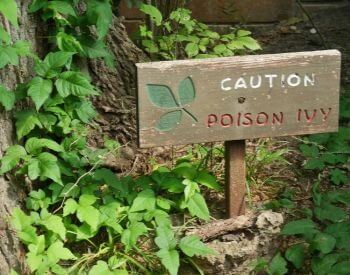
- Plant Name: Poison ivy, eastern poison ivy
- Plant Species: Toxicodendron radicans
- Plant Genus: Toxicodendron
- Plant Family: Anacardiaceae (sumac family)
- Plant Order: Sapindales
- Plant Clade: Rosids
18 Poison Ivy Facts for Kids
- Poison ivy is a plant known to cause urushiol-induced contact dermatitis in humans.
- Urushiol-induced contact dermatitis is the medical term for the rash caused by poison ivy.
- Poison ivy belongs to the genus Toxicodendron, which contains plants that produce the oil urushiol.
- The scientific name for poison ivy is Toxicodendron radicans.
- Poison ivy grows throughout North America and in some parts of China.
- The rash caused by touching a poison ivy leaf is from urushiol, an oil the plant produces.
- The rash caused by touching a poison ivy leaf won’t appear until 24 to 72 hours after contact.
- If you think you’ve touched poison ivy, immediately wash your hands with soap and cold water. This can help remove the oil and perhaps prevent the rash. Time is important with this method; it must be done as soon as possible.
- Not everyone who touches a poison ivy leaf gets a rash. The reaction from urushiol varies greatly among humans. Some people have a very severe reaction, while others have no reaction at all.
- Don’t worry about your pets, only humans and primates appear to have a reaction to urushiol. However, if the oil gets on your pets coat it could transfer to your skin. If you pet encounters poison ivy, you’ll want to bathe it as soon as possible and avoid direct skin contact.
- There are several different subspecies of the poison ivy plant. Some grow as a shrub, some grow as a trailing vine, while others will grow on structures or a tree.
- Poison ivy isn’t easy to identify, it looks like a lot of other plants. However, there are four characteristics of a poison ivy plant you can use to protect yourself.
- A poison ivy plant contains leaf clusters that contain three leaflets.
- A poison ivy plant’s three leaf clusters grow on their own stem and connect to the main vine.
- A poison ivy plant contains leaves that are in an alternate arrangement.
- A poison ivy plant doesn’t have thorns.
- Do not try to remove poison ivy by burning it. The oil that produces the rash can travel with the smoke. This can cause severe pain in your eyes, nose and throat. Not to mention it can get on your skin and still cause a rash.
- The best way to remove a poison ivy plant is to remove it entirely with its roots. Cover your hands, arms and legs completely when you pull it out. Dispose of it in a trash bag and make sure to wash your cloths, be careful when handling them so you don’t transfer any oil to your skin.
Pictures of Poison Ivy

A picture of poison ivy in the summer.

A picture of poison ivy in the fall.

A picture of a posion ivy warning sign.
Find More Facts About Poison Ivy
- Poison Ivy, Oak, and Sumac – Find more information about poison ivy and other plants on the MedlinePlus website.
- How to Identify Poison Ivy – Learn how to identify poison ivy on the WikiHow website.
- Poison Ivy Symptoms – Do you know the symptoms of poison ivy? Learn about them on the Mayo Clinic website.
- Poison Ivy – Wikipedia – Discover more information and facts about poison ivy on the Wikipedia website.
